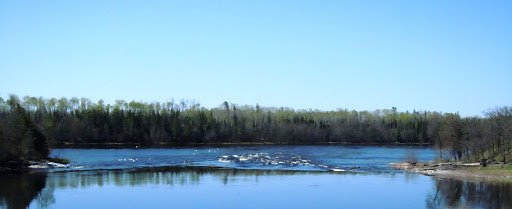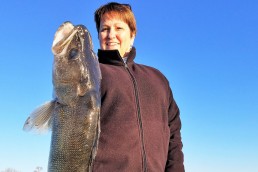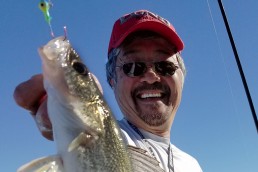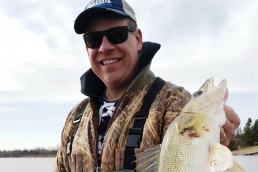Up Your Odds for Spring Rainy River Walleyes
SHARE THIS POST

There is a spring tradition for some anglers that goes back generations. As the warm and welcomed spring sun begins to melt the ice and snow, the Rainy River just east of Baudette, MN begins to show pockets of open water. The open water slowly makes its way to the west and north, eventually ending up in Lake of the Woods.
Even as the ice gives way to open water, thousands of walleyes from Lake of the Woods are making their way upstream to their spawning grounds. With so many fish entering the river, fishing can be phenomenal. Yes, it is a timing thing, but if you hit it right, anglers can catch more trophies in a day than they may catch in a lifetime. This is the spring run on the Rainy River.
It all begins with reports about some open water on the river. News travels fast. Boat access typically begins near the Upper Sault Access (Franz Jevne), which is 28 miles east of Baudette and continues west. After Franz Jevne, the open water progresses west to Birchdale (Nelson Park landing), Frontier landing, Vidas landing (Clementson), Timber Mill Park (east Baudette), Peace Park in Baudette Bay, Bayview public access and finally Wheeler’s Point public access at the mouth of the Rainy River.
Timing
Depending upon the spring, open water often appears as early as the third week of March, but every year is different. The best way to keep abreast of the open water on the river is to keep connected with Lake of the Woods Tourism Bureau’s website and social media. They give daily updates on the progress of the open water, fishing reports, and any other pertinent info.
The first anglers to appear are the brave souls who elect to bring up smaller boats that can be pushed across the shore ice and carefully slid into the icy waters. These are the pioneers of the walleye run and obviously “safety first” has to be the mantra here. Most anglers wait for the accesses to be ice-free. The county is good about using backhoes to help speed up the natural process of the access ice moving out.
There are a handful of fishing techniques that stand out for catching walleyes during the spring walleye run. These techniques are valuable; keep them to yourself!
Vertical Jigging
Tackle during this time is simple. A good jigging rod, a handful of jigs and either minnows or bright plastics will do the trick.
For most, a jig and minnow, preferably an emerald shiner, is the go-to bait during this cold-water period. Brightly colored, glow and gold jigs are a good start. Most of the walleyes will be hungry, but want the bait moving slow, as they are not in a chasing mode. Don’t worry about using a heavier jig. A light jig can rise up and move too fast in the current. There is also less control. Depending upon the flow of the river, start out with a 3/8- or 1/2-ounce and go from there. Don’t be afraid to go heavier if the water is moving quickly. This heavier jig will slow down your offering, just the way the walleyes want it.
Many anglers will vertically jig over the side of the boat, working the bottom foot of the water column. Anchor up and give it 30 minutes in a spot before moving. Many anglers will anchor up on key spots such as a hole, bar or current seam. Many times, groups of walleyes are on the move and will come to you.
Slip Jigging
On occasion, walleyes will want a little “angle to the dangle,” meaning they like baits presented more horizontally. Try working a section of water by slowly using your trolling motor, or if there’s strong current, your kicker to motor slowly upstream. Pull your jig slowly forward and drop it back until it hits bottom. Sometimes, it never makes it to the bottom, as the walleyes normally hit it on the drop. Drift back downstream, using a trolling motor to slow your drift if necessary, and repeat.
Pitching Shorelines
Some anglers prefer casting and working the shoreline. The key here is a controlled drift, making sure you are not ripping downriver too fast. Some years, the current works good for this; other years, the assistance of an electric trolling motor is helpful.
Are you enjoying this post?
You can be among the first to get the latest info on where to go, what to use and how to use it!
Vary your jigging technique until you get dialed in. Cast your offering upstream at about ten o’clock and slowly work the bottom with short little jumps or a slow steady retrieve. Experiment. This kind of fishing does not have to be rocket science. It is just jigging. Get your jig with bait in front of some of these pre-spawn walleyes and they will grab it.
In this cold water, especially when casting, many anglers prefer plastic baits on their jigs and do very well. Plastics seem to shine in cold water. If pitching jigs into dirty water or mudlines, plastics can actually outfish live bait. In turbid water, plastics seem to have better “fish-calling” qualities than live bait. They are louder, vibrate more and distribute scent.
Again, bright-colored plastics in this stained, and sometimes stirred-up water is a good choice. It can also be helpful to have some action or vibration on the plastic body, such as ridges, a paddle tail or a twister tail.
Trolling Crankbaits
Believe it or not, slow trolling a crankbait can also be super effective. Putting your lure in front of many walleyes will get active fish to respond, or for more inactive fish, reaction strikes. Don’t fall for the old wives’ tale that you cannot troll in cold water. I have seen too many times; it simply isn’t true. Trolling not only puts big fish in the boat; it is a good technique to cover water and figure out where the fish are.
This time of year, the walleyes are moving upstream in schools. As you decide where to fish, do not overlook shallow water. Just 3 to 7 feet of water can hold a lot of fish—and big fish. If you work a few sections of shallow water with limited results, slide a bit deeper. With the naturally stained water and spring runoff, light penetration in the shallow depths is better, and fish will see your offering easier vs. in the deeper depths.
The walleye season on Lake of the Woods and the Rainy River is open until April 14th. From March 1 thru April 14, there are special spring fishing regulations for Four Mile Bay and the Rainy River, this is a catch-and-release season only, however, most anglers aren’t here for fillets. They are here to have the chance to catch monster walleyes, and potentially numbers of them.
Lodging
As far as lodging, the hotels and resorts around Baudette are a natural choice. During prime time, if the closest properties on the river or in town are full, there are numerous resorts north of Baudette which typically have openings, along with restaurants and bars. To make it easy, there is an entire list of lodging at the Lake of the Woods Tourism website, LakeoftheWoodsMN.com.
The small businesses of Baudette will have most everything you need. Bait shops carry the hot jigs, plastics and live bait. Hardware stores, restaurants, coffee shops and souvenir retailers are buzzing this time of year. Things are hopping and people are excited.
The spring run of walleyes is tradition and an exciting time in these parts. Almost a rite of passage to the warmer months ahead, it marks the official start of open-water fishing that many anglers have been looking forward to. It seems only appropriate that the kickoff to the open-water season involves some of the largest walleyes in the land stacked up in one beautiful river. Game on!
Information on the new 2019 regulations for Lake of the Woods as well as the Rainy River can be here.
Become a MidWest Outdoors Insider Here!
MWO
SHARE THIS POST
Did you enjoy this post?
You can be among the first to get the latest info on where to go, what to use and how to use it!
Joe Henry
Tournament angler and licensed charter captain Joe Henry fishes and hunts the Midwest. Henry is a media member of AGLOW and writes for numerous publications, creates videos, appears on a variety of outdoor TV and radio shows and is a frequent seminar speaker. Henry is the Executive Director of Lake of the Woods Tourism.



